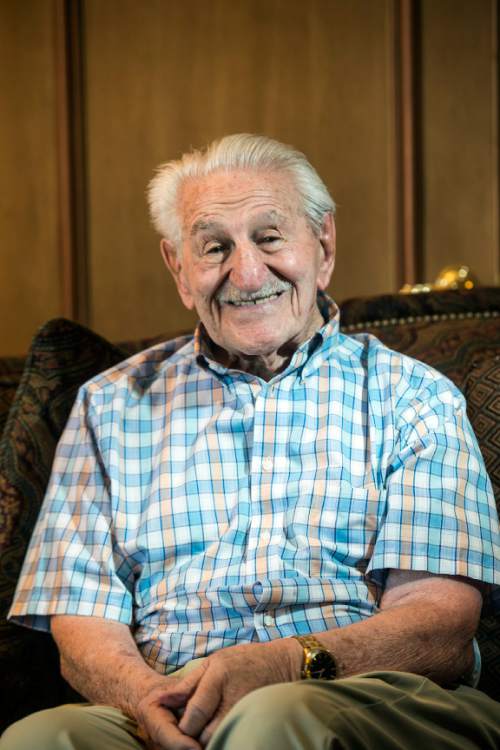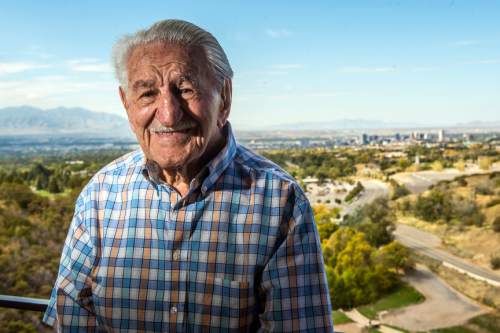This is an archived article that was published on sltrib.com in 2015, and information in the article may be outdated. It is provided only for personal research purposes and may not be reprinted.
Editor's note • In this regular series, The Salt Lake Tribune explores the once-favorite places of Utahns, from restaurants to recreation to retail.
—
At a time when Mexican cuisine was rare in Salt Lake City, Louis and Athena Nichols knew there was a Utah appetite for Tex-Mex.
By 1967, Louis had owned a stock brokerage and Windsor Lounge, and had run a bar called the Boulder. He saw the popularity of Mexican restaurants like the Tampico, a casual eatery that opened in Salt Lake City after World War II, and he wanted to try it out.
"Tampico had people waiting in lines to get in," Louis said. What was missing, he figured, was a fine dining experience.
Louis and Athena enlisted the help of a friend, Ethel Vasquez, who had learned the art of Mexican cooking from her Mexican husband.
That's when the idea for the chandelier-adorned Señor Pepe's, one of Salt Lake City's favorite restaurants of the 1970s and '80s, was born.
Dedicated to the city's downtown, Louis bought the building at 216 S. State Street from a man who owned a Western clothing store. The Nichols bought the inventory of boots and cowboy hats, liquidated it and renovated the building, opening the restaurant in 1968.
Low, leather booths lined the sides of the room, with tables in the center atop deep red carpet. The brick walls were painted white and bright paper flowers of all sizes lined the walls and blossomed between booths.
"Nobody had seen a Mexican restaurant that was that nice when it first opened," said Kathy Draper, one of the couple's daughters. "It was known for its paper flowers and being colorful."
The food was classic Tex-Mex: combination plates with tacos or cheese enchiladas, flautas and sopapillas (a Mexican scone), and the restaurant's famous chile verde. Tapioca pudding and Snelgrove's ice cream were served for dessert.
Jackson, Wyo., native Lance Davidson remembers dining at Señor Pepe's when he visited Utah during his teenage years.
"Going there to eat was always a high point of downtown Salt Lake City for me," said Davidson, who recalls the restaurant being dimly lit with dark woods, and the waitresses wearing white, traditional Mexican blouses and long, vibrant skirts.
—
A downtown draw • Originally, Louis called the restaurant Señor Peco's. But after a San Francisco restaurant named Señor Pico caught wind of Nichols' success and sued for the name, Señor Peco's became Señor Pepe's.
The Nichols redecorated in the mid-1970s, losing the paper flowers created by one of Athena's friends. The walls remained white, decorated with faux stained glass windows.
"We were clean and new," Louis said. "We made an effort to make it look like having Mexican food was just as good as having American food."
The spot was popular among business people, making lunchtime the restaurant's busiest hours, Draper said.
But many people ate there during shopping excursions, too. Señor Pepe's wasn't far from Salt Lake City's downtown department stores at the time: Auerbach's, Woolworth's, J.C. Penney and the like.
Ken Gourdin grew up in Tooele and remembered Señor Pepe's as one of his "first cultural experience with things Mexican." His family would visit the restaurant every time they came downtown.
Back then, he said, it wasn't common to hear Mexican music or see someone wearing a traditional sombrero. "I always felt like the owners' goal was to give people that experience," he said.
Famous people stopped by, too. Comedian Phyllis Diller ate at the restaurant, as did the original Batman actor, Adam West. Players for the Utah Stars, the predecessor of the Utah Jazz, were also known to frequent the restaurant.
One day, Liberace came in, "all dressed up" and "just adorable," said another Nichols daughter, Kari Burgess.
—
Family business • Athena, her daughters said, was the heart of the restaurant, training waitresses, greeting patrons and making sure the food was presentable. "She was the real boss," Burgess said of her mother, who died in 2009. Athena had learned the value of hard work and service from her father, who worked as a candy decorator in Crete, Greece, Burgess said.
Louis was the numbers man: "I was always there to make sure service was right, and the price was right."
At its opening, a combination lunch plate was about 95 cents, Burgess said.
Nichols' four daughters also pitched in daily, taking over waitressing or busing tables and taking care of the restaurant when their parents were gone.
"I loved having my girls work for me," Louis said. "I paid them, of course, but they were very interested in the restaurant."
The Salt Lake City flood of 1983 turned State Street into a river for weeks and destroyed business for Señor Pepe's that summer, but the family recovered. And grandkids didn't miss out — Draper said both her daughters learned to speak Spanish by working with cooks and other staff.
—
Downturn downtown • In Señor Pepe's heyday, its neighbors on State Street were "mom-and-pop shops," Burgess said.
But the 1980s were not kind to local businesses in downtown Salt Lake City, with the opening of Crossroads Plaza and ZCMI malls, and many shoppers headed to restaurants and malls in the suburbs.
Ken Sanders, a rare book dealer who grew up in South Salt Lake, said he believes redevelopment projects that began in the 1970s are to blame, at least in part, for the demise of local businesses downtown. The two malls anchored at one side of town also threw the business area off balance, he said.
"I don't think there's a downtown restaurant left from my youth," Sanders said.
"Everybody used to walk to our restaurant from work or shopping," Burgess said. "But soon all the area vacated. It killed that whole end of town."
The restaurant closed in 1989 and Nichols, along with other business owners on the block, sold to the Salt Lake City Redevelopment Agency.
"We were all sad. It was such a part of everybody's life for 20 years," Draper said, adding that running a restaurant takes dedication. Burgess added: "Mom and Dad were ready to relax."
—
If you have a spot you'd like us to explore, email whateverhappenedto@sltrib.com with your ideas.











